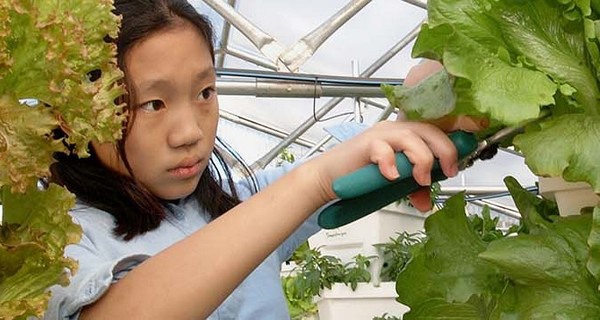Harvested on more than 342,000 acres across the nation, lettuce represents a $2 billion industry mostly situated in California, Arizona, and Florida, according to the U. S. Department of Agriculture (USDA) Census Data. In Florida, more than 10,000 acres of lettuce are harvested during cool and short days of late fall to early spring. Most production occurs in the Everglades Agricultural Area located just below Lake Okeechobee in Palm Beach County.

Fifth grader harvests hydroponically grown lettuce in a greenhouse as part of UF/IFAS elementary school program. Credit: UF/IFAS
With consumers seeking to grow more produce at home year-round, fall is primetime for tossing lettuce into the mix of vegetables to grow in your garden no matter how small or large your space.
Germán Sandoya-Miranda, assistant professor of lettuce breeding and genetics at the University of Florida Institute of Food and Agricultural Sciences (UF/FAS), has coauthored “Growing Lettuce in Small Hydroponic Systems” offering insights, resources, and best practice tips for the home grower.
Additional gardening leisure
“Lettuce is planted in Florida fields from October to March and consumers start enjoying lettuce produced in the state from the beginning of December to end of April,” said Sandoya, whose work on lettuce breeding and disease research is based in Belle Glade at UF/IFAS Everglades Research and Education Center. Producing lettuce in small hydroponic systems can provide citizens additional gardening leisure and the opportunity to consume their own fresh product, from “farm to table.’”
The article, released on Askifas, the peer-reviewed Electronic Database Information System (EDIS) platform from UF/IFAS, goes into detail on the benefits of growing lettuce in controlled environments, what to consider to make it work for small settings like patios and home gardens, tips on media and irrigation options, as well as resources to get you started on growing your own tasty bed of greens.
“Hopefully our publication can give Floridians a starting point in producing their lettuce at home,” said Jonael Bosques, a co-author of the publication and director of UF/IFAS Extension Hardee County.
In homes or condos, where there is limited space or sunshine, lettuce can be grown and supplemented with the day’s light hours to create ideal growing conditions, he adds.
“One takeaway to keep in mind is that growing indoors doesn’t mean our plants will be perfect all the time,” said Vanessa Campoverde, an agent specializing in ornamental plant nurseries at UF/IFAS Extension Miami Dade County who contributed to the article. “That is why we need to monitor their growth and especially their health. Make it part of your routine while checking on your indoor or outdoor hydroponic systems."
“Some issues associated with lighting, nutritional deficiencies and temperature make this crop an ideal one for beginners. There are a lot of varieties to choose from, and there are some marked differences in the way they respond to different environments and growing conditions,” said Sandoya.
For more information: UF/IFAS
UF/IFAS
www.ifas.ufl.edu
